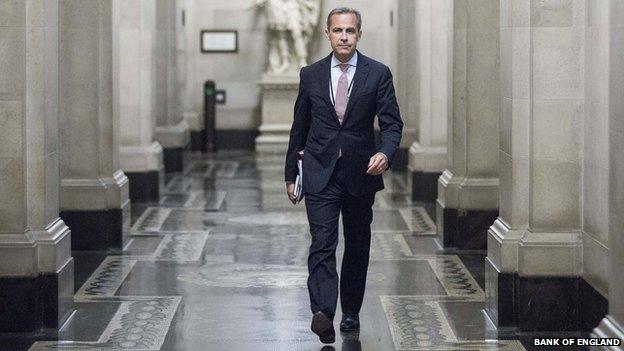The Bank of England's theory of everything
- Published

Bank of England governor Mark Carney has more than just interest rates to worry about
It is not quite astrophysics, but monetary policy is undergoing a radical rethink.
Setting interest rates is not the only thing the Bank of England focuses on anymore. But what does the newly expanded powers of the central bank mean for rates?
To answer that question (and pretty much everything about post-crisis monetary policy), the Bank of England organised a conference with a live webcast to discuss how to make its research suit its new policymaking tools.
It is one of the central banks that now has the task of ensuring financial stability in addition to targeting inflation.
In other words, the Bank sets what is called macroprudential policy, which aims to prevent another banking crisis. It also oversees individual banks, under what is called the Prudential Regulatory Authority.
Theory vs practice
So, the Bank of England has these new tools, but how to make them work well together? You might think it should have figured that out beforehand.
Well, governor Mark Carney said that the Bank is trying to get "theory to catch up with practice".
I can hear the jokes about economists being trotted out.
Here's a classic: An economist is someone who finds something works in practice and wonders whether it works in theory.
There's the former Federal Reserve chairman Ben Bernanke's version: "The problem with QE is that it works in practice, but it doesn't work in theory."
Or, in the words of former US Congressman Dick Armey: "Economics: the science of telling you things that you have known your whole life, but in a language that you can't understand."
Inflation not the only concern
Now, for the important question - how does what the Bank of England is doing affect interest rates?
It is clear that inflation is not the only concern anymore.
Although it is unclear what the target is when it comes to financial stability (that's hardly reassuring), managing it is a goal.
The instruments are not interest rates, but macroprudential tools, such as countercyclical capital requirements (essentially an insurance policy against unemployment, or other bad economic conditions) or leverage ratios (the amount of debt a bank can have in relation to its holdings).
Still, it is all connected. For instance, if banks are lending too much or too little, then the cost of borrowing - the commercial interest rate - will be affected by the supply and demand for credit.
In other words, the interest rate we pay on our mortgages and business loans is not directly set by the Bank of England.
It is commercial banks and other financial institutions that base the cost of our loans on the rate of the Bank.
Even how much they lend can be affected by the Bank, since it can ask for more or less capital to be set aside by banks.
But, for the businesses frustrated by the low amount of bank lending since the crash, regulation does not seem to be the main issue.
One way to think about the new system is that the central bank sets the interest rate, which remains focused on the 2% inflation target.
The Bank also now directly influences more of the monetary transmission mechanism that transmits that base rate through the financial system. By regulating banks and the financial sector, the central bank has more sway over the operations of the lending system.
The Bank officials themselves asked where the boundaries of macroprudential policies end and those that govern monetary policy that targets interest rates start.
It is not very reassuring, but the answer was that no one knows.

A run on Northern Rock in September 2007 sparked a banking crisis.
One chart that seemed to sum up the day was presented by the Bank's chief economist, Andy Haldane.
He showed a word count of the minutes of the Monetary Policy Committee, the body that sets rates. It showed that the word "banks" rarely appeared in discussions before the collapse of Northern Rock that led to the first bank run in a century a few years ago. Now, it appears frequently.
What that means for how the MPC operates alongside other parts of the Bank with these new mandates will evidently require more research in the years to come.
But, one thing that struck me throughout the conference was that there was little discussion about how interest rates should be set to meet the inflation target. There will be changes in the future, but for now, we will still be mainly watching inflation.